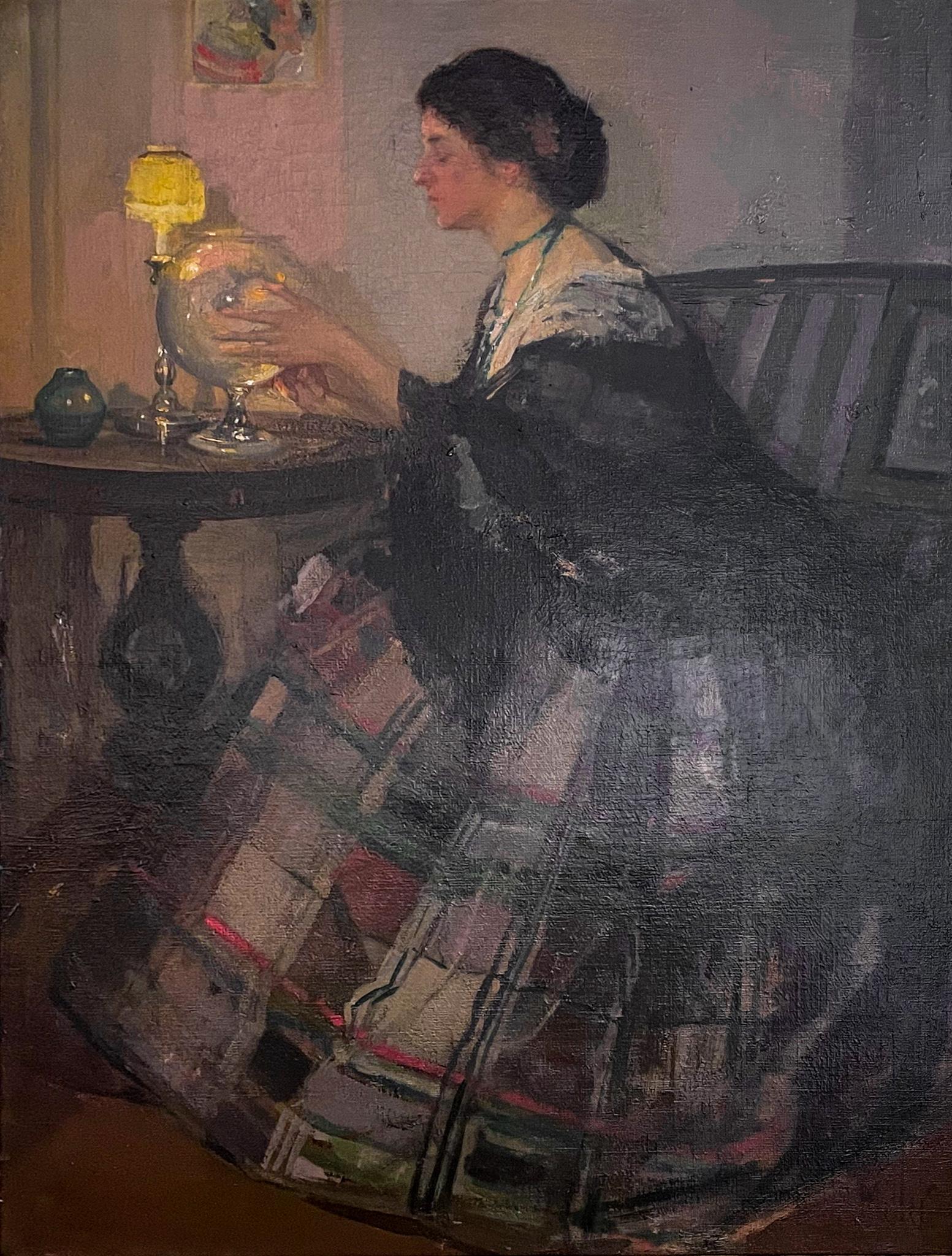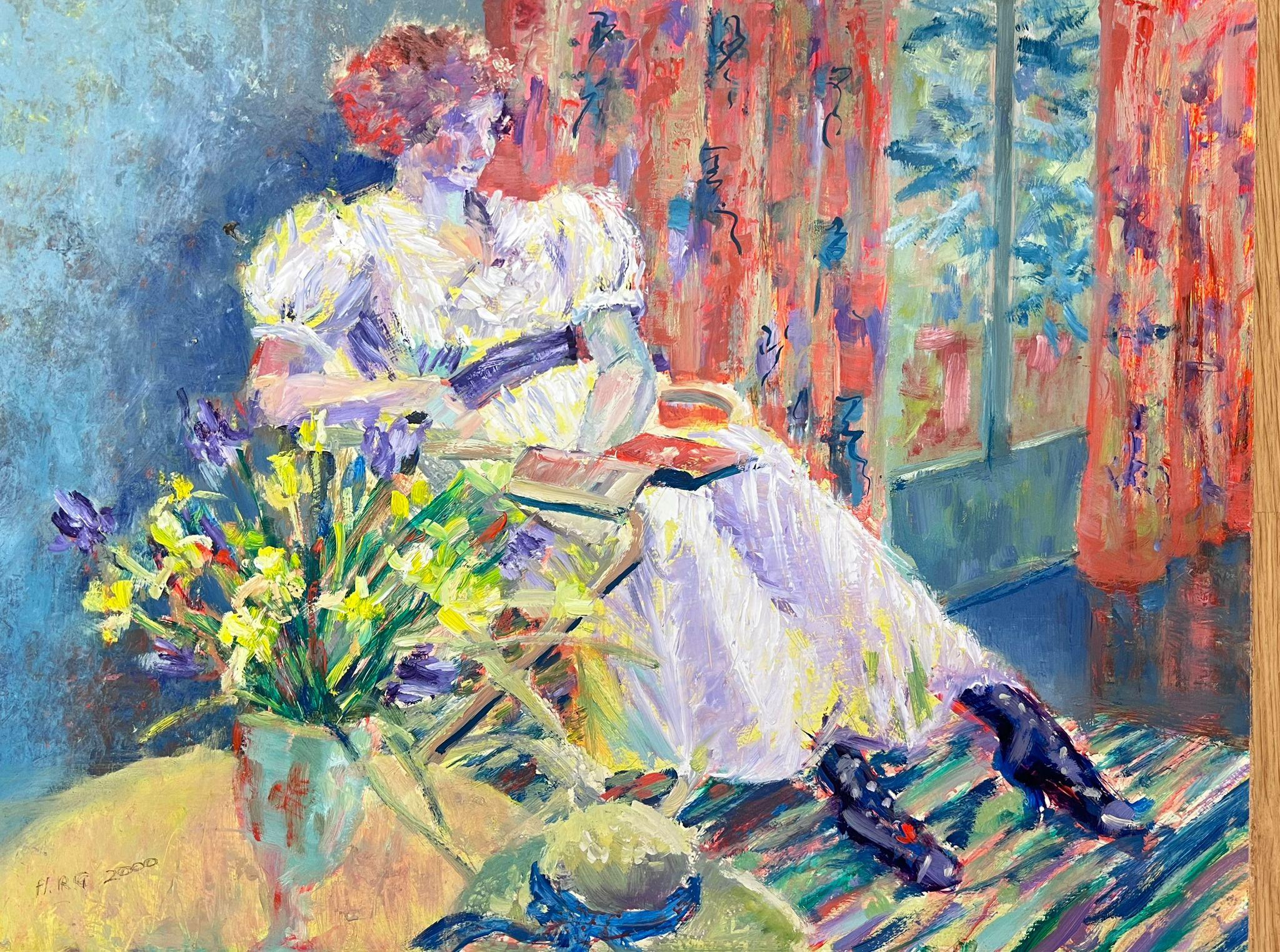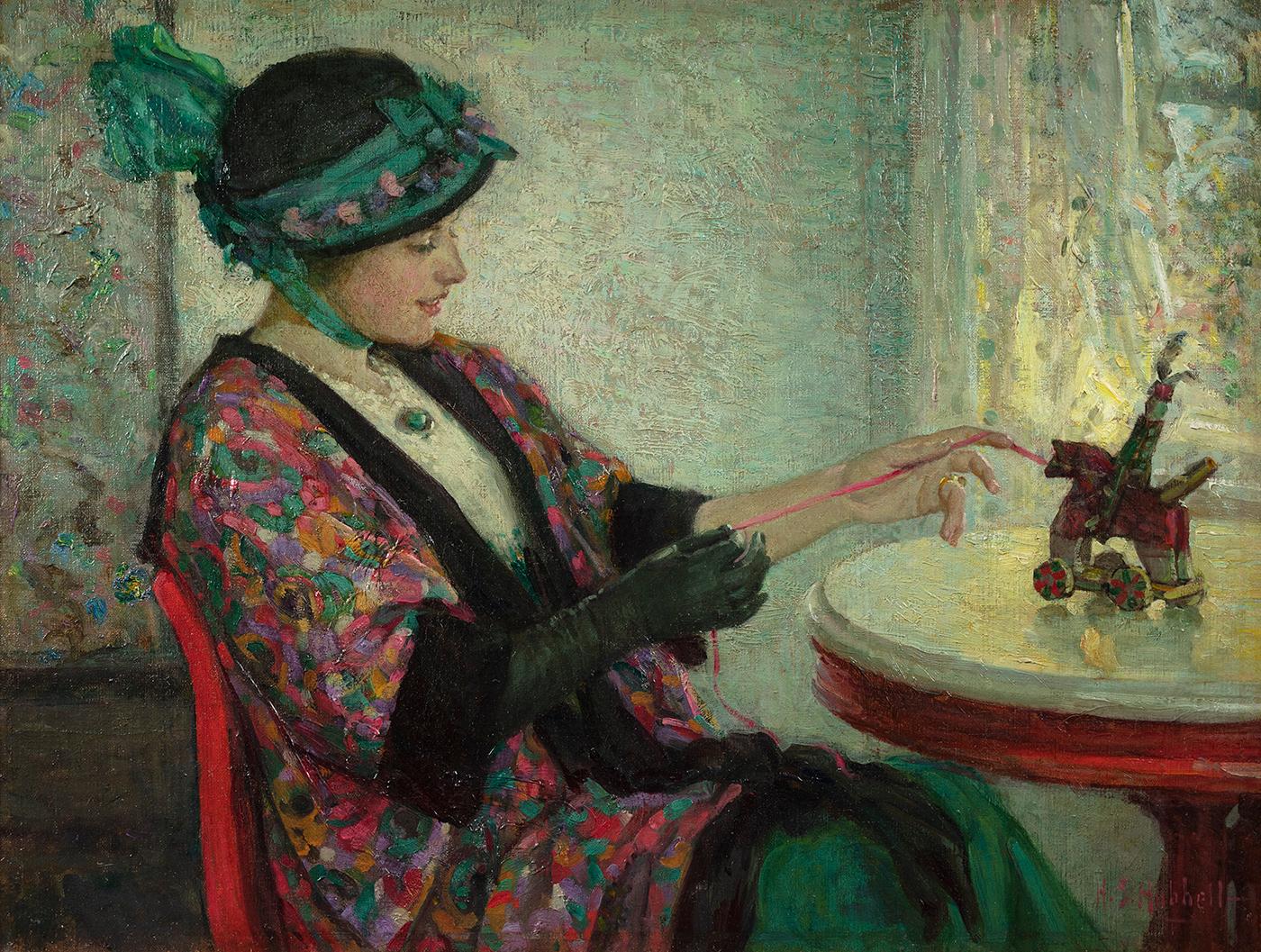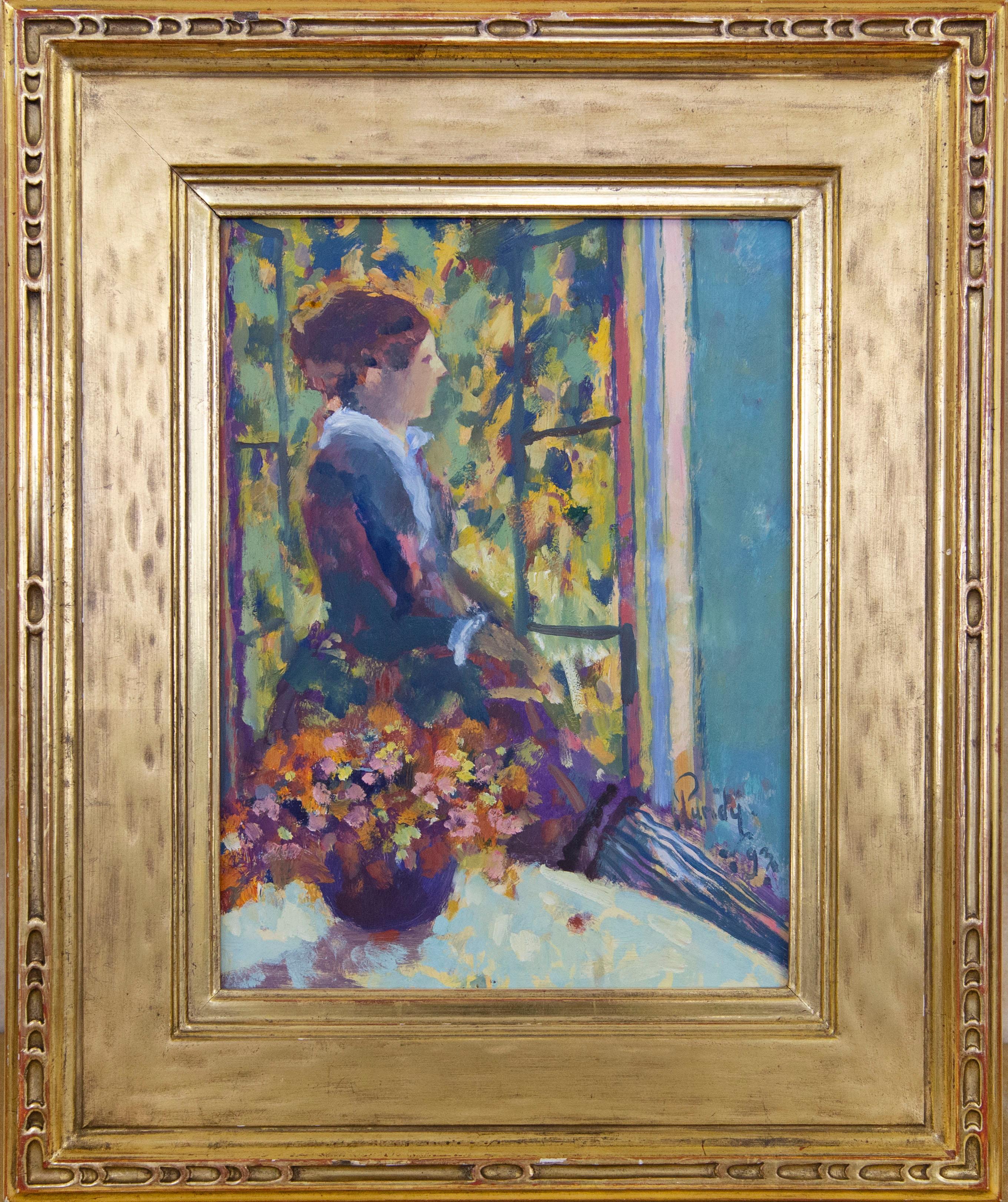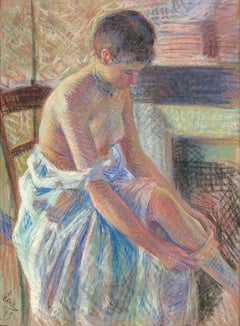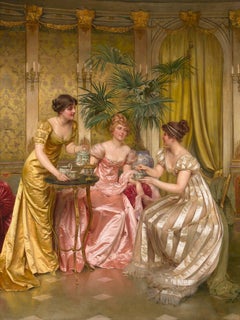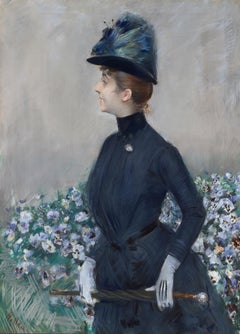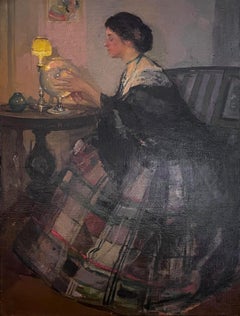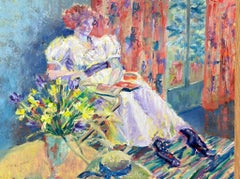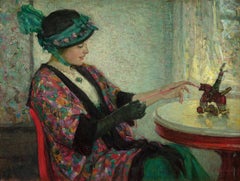Items Similar to Young Woman in Interior by Richard E. Miller
Want more images or videos?
Request additional images or videos from the seller
1 of 9
Richard Edward MillerYoung Woman in Interior by Richard E. MillerCirca 1910
Circa 1910
$685,000
£529,281.32
€611,899.10
CA$967,954.53
A$1,085,625.39
CHF 568,525.20
MX$13,191,407.09
NOK 7,219,317.75
SEK 6,844,421.88
DKK 4,567,506.71
About the Item
Richard E. Miller
1875-1943 American
Young Woman in Interior
Signed "Miller" (lower right)
Oil on canvas
Richard E. Miller's Young Woman in Interior exemplifies the artist's exceptional mastery of light, color and feminine beauty that established him as one of the most significant American artists of the early 20th century. This captivating work transports viewers to an intimate domestic scene where a young woman, seated at a window overlooking her garden, delicately stirs her tea in a moment of quiet contemplation.
This colorful composition demonstrates Miller's sophisticated technique through its masterful contrasts—the sweeping folds of the subject's dark skirt juxtaposed against the sunlit foliage beyond the window, the luminous rendering of her smooth hands and bare shoulders against the energetic brushwork of her garments. These elements create a visual symphony that captures the fleeting quality of light and atmosphere so prized by the Impressionists.
Miller developed his distinctive artistic voice during his time in Paris at the end of the 19th century, where he was immersed in the vibrant artistic circles of the period. Unlike many American artists who merely adopted European styles, Miller cultivated a personal approach to Impressionism that would define his oeuvre. This evolution reached its peak when he settled in Giverny, France—the legendary artist colony where Claude Monet and numerous other luminaries lived and worked. It was amid this creative community of the "Giverny Luminists" where Miller refined his signature subject: young beauties in light-filled domestic settings, like this work.
Born in St. Louis, Missouri, Richard Edward Miller emerged as one of America's most significant Impressionist painters through his extraordinary sensitivity to light and feminine beauty. After training at Washington University's School of Fine Arts, Miller moved to Paris for nearly fifteen years, where his technical virtuosity earned him acceptance at the prestigious Paris Salon by 1901, and eventually to Giverny where his mature style fully flourished. Following his return to America during World War I, he taught at the Pennsylvania Academy of Fine Arts before settling in Provincetown, Massachusetts, garnering numerous accolades including gold medals at the St. Louis Universal Exposition (1904) and Panama-Pacific International Exposition (1915). Today, his works grace the permanent collections of prestigious institutions, including the Metropolitan Museum of Art, the Art Institute of Chicago and the Smithsonian American Art Museum.
Circa 1910-11
Canvas: 35 5/8" high x 28 1/4" wide (90.49 x 71.76 cm)
Frame: 45 5/8" high x 38 1/4" wide x 2 3/4" deep (115.89 x 97.16 x 6.99 cm)
Provenance:
Collection of the artist
Alexander M. Hudnut, acquired from the above
Walter P. Chrysler Jr., New York, Chrysler Art Museum, Provincetown, MA, 1966
Hirschl & Adler Galleries, New York, 1980
Brand Galleries, San Francisco
Private Collection, acquired from the above, 1982
M.S. Rau, New Orleans
Exhibited:
(Possibly) New York, Macbeth Gallery, Exhibition of Paintings by Richard E. Miller, April 1-20, 1912, no. 4 (as A Dish of Tea)
- Creator:Richard Edward Miller (1875-1943, American)
- Creation Year:Circa 1910
- Dimensions:Height: 45.63 in (115.91 cm)Width: 38.25 in (97.16 cm)Depth: 2.75 in (6.99 cm)
- Medium:
- Movement & Style:
- Period:
- Condition:
- Gallery Location:New Orleans, LA
- Reference Number:Seller: 32-07731stDibs: LU18616042212
Richard Edward Miller
Richard E. Miller was an American Impressionist who was known for his paintings of romantic femininity. He began his studies in America at the St. Louis School of Fine Arts before receiving a scholarship that allowed him to study in Giverny, France. While studying in Europe with artists like Frederick Frieseke, Miller became inspired by his neighbor Claude Monet, and adopted a lighter, Impressionistic style. Miller went on to produce exteriors of porches and lawns containing idealized women, who he often painted in large, decorative dresses. In France Miller received a gold medal from the Paris Salon and was knighted into the French Legion of Honor. He later co-founded the Provincetown Artists Colony in Cape Cod, Massachusetts.
About the Seller
5.0
Vetted Professional Seller
Every seller passes strict standards for authenticity and reliability
Established in 1912
1stDibs seller since 2013
17 sales on 1stDibs
Typical response time: 11 hours
- ShippingRetrieving quote...Shipping from: New Orleans, LA
- Return Policy
Authenticity Guarantee
In the unlikely event there’s an issue with an item’s authenticity, contact us within 1 year for a full refund. DetailsMoney-Back Guarantee
If your item is not as described, is damaged in transit, or does not arrive, contact us within 7 days for a full refund. Details24-Hour Cancellation
You have a 24-hour grace period in which to reconsider your purchase, with no questions asked.Vetted Professional Sellers
Our world-class sellers must adhere to strict standards for service and quality, maintaining the integrity of our listings.Price-Match Guarantee
If you find that a seller listed the same item for a lower price elsewhere, we’ll match it.Trusted Global Delivery
Our best-in-class carrier network provides specialized shipping options worldwide, including custom delivery.More From This Seller
View AllAt the Mirror
By Frederick Carl Frieseke
Located in New Orleans, LA
the most important American Impressionists of his age. While many of his contemporaries focused on the landscape, Frieseke gained his inspiration from the figural, and in particular the theme of femininity. His works capture female figures engaging in traditionally feminine roles — strolling in the garden or posed in a domestic interior. At the Mirror...
Category
Early 20th Century Impressionist Nude Paintings
Materials
Oil, Canvas
Femme mettant ses bas by Maximilien Luce
By Maximilien Luce
Located in New Orleans, LA
Maximilien Luce
1858-1941 French
Femme mettant ses bas
(Woman putting on her stockings)
Pastel on paper
Signed "Luce 89" (lower left)
Maximilien Luce’s Femme mettant ses bas is a...
Category
19th Century Post-Impressionist Figurative Drawings and Watercolors
Materials
Paper, Pastel
Afternoon Tea by Charles-Joseph-Frédéric Soulacroix
Located in New Orleans, LA
Charles-Joseph-Frédéric Soulacroix
1825-1879 French
Afternoon Tea
Oil on canvas
Signed "F. Soulacroix" (lower right)
A charming trio sits down for afternoon tea in this enchantin...
Category
19th Century Figurative Paintings
Materials
Oil
La femme aux fleurs (Portrait de Mathilde See)
By Paul César Helleu
Located in New Orleans, LA
Paul César Helleu is regarded among the most sought-after society portraitists of his era, and his Belle Époque works rival those of his contemporaries John Singer Sargent and Giovanni Boldini. He is best remembered for capturing the era's most beautiful socialites, including Consuelo Vanderbilt, the Duchess of Marlborough, the Comtesse de Loriol Chandieu and the Comtesse Mathieu de Noailles, among others. This work, however, stands out in that it captures the charming likeness of one of his art world cohorts, Mathilde See, a Parisian-born decorator and painter of floral still lifes. She is the essence of the modern woman, captured in her fashionable dress as she strolls along the flower-lined streets of Paris.
Commanding in size, Portrait de Mathilde See fully displays Helleu's mastery over the medium of pastel. The muted palette of greys and blues is typical of the artist, bringing a harmony and cohesiveness to the composition. Furthermore, Helleu cleverly alludes to See's own artistic output with a backdrop of vibrant floral blooms, enlivening the canvas and complementing the greens and blues of the peacock feather adorning her hat.
The portrait is all the more significant thanks to its provenance. It was previously in the collection of A. Alfred Taubman, one of America's most successful entrepreneurs and one-time owner of Sotheby's. Considering Taubman encountered some of the most noteworthy and beautiful works of art ever made through his auction house, the fact that he chose this portrait by Helleu to grace his collection is a testament to its import.
Born in Brittany in 1859, Helleu moved to Paris in 1876 in order to study at the École des Beaux-Arts. Like so many other artists of his generation, he was trained there under the Academic master Jean-Léon Gérôme. That same year, he also attended the Second Impressionist Exhibition...
Category
20th Century Modern Portrait Paintings
Materials
Linen, Pastel
The Bather by Childe Hassam
By Childe Hassam
Located in New Orleans, LA
Childe Hassam
1859-1935 American
The Bather
Signed and dated “Childe Hassam” (lower right)
Oil on canvas
Considered by many to be America’s foremost Impressionist painter, Childe Hassam composed his tranquil and intimate oil on canvas The Bather in the early years of the 20th century. The creation of the artwork aligns with a period of Hassam’s career where the artist’s palette was transforming, matching ever closer with the pale and pastel hues of French Impressionists like Claude Monet. Even the subject — a nude woman — represents a greater alignment with the Impressionist project, as artists of the movement and their non-mythological and non-biblical nudes still generated cries of indecency. With Hassam’s signature brushwork and attention to color, The Bather serves as a dream-like vision, serene and sensuous, of a young woman bathing in a lush forest.
While the artist's skill for landscape painting is on display, it is Hassam's command of form, light and color that brings this canvas to life. He creates a captivating composition, placing the nude subject in the bottom left of the canvas. The soft, undulating curves of the woman's body in contrapposto and the glow of her fair skin are balanced by the strong verticals and deep earth tones of the tall trees to her right. Hassam delicately frames the nude in the vivid blues of the distant water, building luminous color that further draws the viewer’s eye and results in a somewhat voyeuristic appeal — endowing his nude with both a natural innocence and an intentional sensuality.
Born in Dorchester, Massachusetts, Childe Hassam began his artistic career as a freelance illustrator, working for national publications such as Harper’s Weekly, Scribner’s Monthly, and The Century. His first solo exhibition of watercolors took place in Boston in 1883, and he quickly catapulted onto the international scene, winning a bronze medal at the Exposition Universelle in Paris in 1889. The year before the present work was created, he received the Webb Prize from the Society of American Artists for another landscape painted at Gloucester. Hassam would receive numerous other awards throughout his career, most notably the Gold Medal for Distinguished Services to Fine Art from the American Dealers Association. A true master, Hassam depicted a way of life characteristic of both American and French society, and his work elucidates a critical chapter in American art history. Today, his work resides in the Oval Office of the White House and in numerous important museums, including the Metropolitan Museum of Art in New York, the National Gallery of Art in Washington, DC and the Museum of Fine Arts in Boston, among others.
This painting will be included in Stuart P. Feld's and Kathleen M. Burnside's forthcoming catalogue raisonné of the artist's work.
Circa 1905
Canvas: 24 1/2“ high x 20 18” wide
Frame: 35 7/8“ high x 31 1/4” wide x 3 1/4“ deep
Provenance:
Private Collection of William Young...
Category
20th Century Impressionist Nude Paintings
Materials
Canvas, Oil
La lecture au jardin (Lesson in the Garden)
By Georges d'Espagnat
Located in New Orleans, LA
French Post-Impressionist painter Georges d’Espagnat captures a charming moment between a mother and her child in this vibrant oil on canvas. Rendered with a studied use of complementary colors and bold brushstrokes, the painting showcases the artist's unique Post-Impressionist style. Remembered as one of the most individualistic artists of the 20th century, his distinctive canvases bring together the loose brushwork of the Impressionists and the bold color palette favored by the Fauves. Together, they achieve a vibrant spontaneity that lends itself well to the carefree subjects of the present work.
Masterfully composed, La lecture au jardin moves beyond the Impressionist instinct to capture a fleeting moment on canvas. Rather, d'Espagnat succeeds in creating a deep feeling of harmony in the work. Warm colors are perfectly balanced with cool tones, while vertical and horizontal lines are softened by the curves of the foliage and his subjects' figures. Through his simplification of forms and intentional use of color and line, he creates a scene that is carefully designed and thoroughly modern. A similar view of a mother and her child by d'Espagnat is currently in the collection of the Metropolitan Museum of Art (New York).
The Post-Impressionist painter was an individualist since his youth, choosing to forgo traditional schooling in order to independently study the Old Masters in the Louvre. He soon became involved with the most prominent Impressionist and Post-Impressionist painters of the age, including Pierre-Auguste Renoir and Paul Signac, who themselves existed outside the traditional norms of French Academic training. In 1891, he exhibited at the Salon des Refusés, and again the following year at the Salon des Indépendants.
By 1895, he held his first one-man show in Paris, and just three years later his success earned him a solo show at the prestigious Durand-Ruel Gallery. Between 1905 and 1910 he made several trips to visit Renoir on the Côte d’Azur. Their close friendship resulted in a group exhibition at Marcel Bernheim...
Category
Late 19th Century Post-Impressionist Portrait Paintings
Materials
Canvas, Oil
You May Also Like
The Goldfish Bowl
By Richard Edward Miller
Located in New York, NY
The Goldfish Bowl by Richard Miller (1875-1943)
Oil on canvas
37 ½ x 29 ¾ inches unframed (95.25 x 75.565 cm)
46 ⅝ x 36 ¼ inches framed (118.428 x 97.155...
Category
Early 20th Century American Impressionist Figurative Paintings
Materials
Oil
Price Upon Request
Interior with Lady Reading - Scottish Edwardian 1910 art portrait oil painting
Located in London, GB
This superb Scottish Edwardian Impressionist interior oil painting is by noted Scottish female artist Annie Rose Laing. Painted circa 1910, the composition is the interior of a room...
Category
1910s Impressionist Interior Paintings
Materials
Oil
English Impressionist Oil Painting Lady In White Dress Reading In Bright Room
Located in Cirencester, Gloucestershire
Lady Reading
by Helen Greenfield (British 20th century)
signed initials oil painting on board, unframed
dated 2000
board: 17.75 x 23 inches
condition: overall very good
provenance: ...
Category
20th Century Impressionist Figurative Paintings
Materials
Oil
Young Woman with a Toy
Located in New York, NY
Signed lower right: H. S. Hubbell –
Category
20th Century American Impressionist Figurative Paintings
Materials
Oil
Afternoon Light, Colorful Impressionist Interior
Located in Greenwich, CT
Impressionist artist Purdy often paints figures in tranquil settings that include windows and flowers. The colors of yellow, soft blues and whites here convey a sunny setting. He oft...
Category
1990s Impressionist Figurative Paintings
Materials
Oil, Panel
"Woman Reading in an Interior" Vaclav Vytlacil, Loose Brushwork Portrait
By Vaclav Vytlacil
Located in New York, NY
Vaclav Vytlacil
Woman Reading in an Interior, circa 1915
Signed lower right
Oil on canvas
16 x 20 inches
As a child, Vytlacil had taken art classes at the Art Institute of Chicago....
Category
1910s Impressionist Interior Paintings
Materials
Canvas, Oil
Read More
Paul Revere Crafted This Silver Coffee Pot 250 Years Ago
Perhaps best known as a Revolutionary War hero, Revere was also an accomplished silversmith, and this pot is now available on 1stDibs.
Degas Portrayed These Exuberant Ukrainian Dancers with ‘Orgies of Color’
Discovered in Parisian cabarets, the performers reenergized the artist’s practice.
More Ways To Browse
Miller Vintage
Giverny Art
E M Washington
Giverny Painting
Monet Giverny
Louis Claude Artist
Luminist Paintings
Vintage Claude Skirt
Blue Nile
Brunette Painting
Dinosaur Painting
German School 17th Century
Old Duck Paintings
A Weston Oil Painting
Carousel Oil Painting
China Nude Oil Painting
Jackson Browne
Man And Woman Kissing
